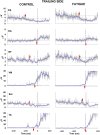Impact of muscle fatigue on anticipatory postural adjustments during gait initiation
- PMID: 39872415
- PMCID: PMC11770096
- DOI: 10.3389/fphys.2024.1520578
Impact of muscle fatigue on anticipatory postural adjustments during gait initiation
Abstract
Introduction: Prolonged or strenuous exercise leads to a temporary decrease in muscle function and performance, which interferes with activity of both prime movers and postural muscles. This effect of fatigue has been reported both for single segment movements and for locomotion. However, little is known regarding the effects of fatigue on anticipatory postural adjustments (APAs) during gait initiation, a task in which the control of focal movement should be strictly coupled to a feedforward control of posture.
Methods: We studied APAs during gait initiation in 16 healthy well-trained adult males, searching for muscle activities that precede the backward shift of the Center of Pressure (CoP). Participants stood on a force plate for about 10 s and then started walking at their natural speed. APAs were evaluated before and after a 1 min exhausting sequence of countermovement jumps. An optoelectronic system captured the heel-off events while a force plate measured the CoP position and vertical ground reaction force. Wireless probes recorded the electromyogram of trunk and leg muscles from both sides.
Results: It was observed that muscle fatigue delayed excitatory and inhibitory APAs, of about 40 and 80 ms, respectively, and a parallel delay was induced on prime movers; moreover, velocity and amplitude of backward CoP shift were reduced. Regarding APAs sign and occurrence, most of the participants showed bilateral inhibition in dorsal muscles and excitation in the ventral ones, displaying a forward "diving" strategy that was almost unaffected by fatigue. However, after fatigue, three of the "diving" participants switched to a "turning" strategy, i.e., they displayed a reciprocal activation/inhibition pattern in the dorsal muscles, compatible with a trunk rotation.
Discussion: The "turning" strategy has been previously described in untrained individuals and in a toes-amputee mountain climber, who showed a "diving" approach to gait initiation when wearing his prosthetic shoes and switched to the "turning" approach when barefoot. Altogether, these results support the idea that one and the same person may develop a repertoire of postural strategies among which the central nervous system will choose, according to the personal fitness and the constraints in which the action is performed.
Keywords: APAs; exhausting exercise; human; postural strategies; trunk muscles.
Copyright © 2025 Storniolo, Farinelli, Esposti and Cavallari.
Conflict of interest statement
The authors declare that the research was conducted in the absence of any commercial or financial relationships that could be construed as a potential conflict of interest. The author(s) declared that they were an editorial board member of Frontiers, at the time of submission. This had no impact on the peer review process and the final decision.
Figures




